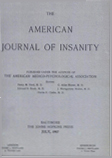ELECTROENCEPHALOGRAPHIC STUDIES IN ORGANIC PSYCHOSES
Abstract
Some correlation exists between the EEG findings and the clinical status of the patient in cases of general paresis, senile psychosis, psychosis with cerebral arteriosclerosis and alcoholic psychosis, Korsakoff type. This relationship is by no means an absolute one. There are cases, acute as well as chronic, in which clinically the patient shows psychotic manifestations and the EEG is normal. In acute cases of organic psychosis where the mental disorder develops rather rapidly, often slow waves can be observed, especially in patients who suffer from marked confusional states, and in cases in which the consciousness is narrowed. In acute cases with only moderate mental impairment, the EEG findings are often normal or borderline. In chronic cases some parallelism exists between the degree of deterioration and the EEG findings. Slow waves can be demonstrated in many cases. They are, however, patients of long standing mental deterioration who did not show noticeable corticoelectric changes. It is possible that if an organic process is very slow in developing, findings are missing for some time because the brain has had an opportunity to adapt itself to the damage. Another possibility is that in some of these cases the structural changes are not so much cortical but are localized in sub-cortical associative areas, producing inconspicuous EEG findings. We found that the electroencephalogram has a distinct diagnostic value in organic psychoses if definite slow waves from one to five per second were present, because in such cases a definite mental impairment was demonstrable, but if the electroencephalogram was normal this did not exclude the presence of an organic psychosis. Due to the fact that no absolute correlation exists between the electroencephalographic findings and clinical observations, the diagnostic value of this method is limited at present until we shall be able to work out a closer correlation between organic psychotic processes and corticoelectric phenomena. We agree fully with the statement made by P. A. Davis and H. Davis that: "Although the psychotic individual cannot be recognized by his EEG, nevertheless, as a group the psychotics have a significantly larger percentage of abnormalities in their EEG's than do normals." This is especially true of patients suffering from the organic type of mental disorders.
Access content
To read the fulltext, please use one of the options below to sign in or purchase access.- Personal login
- Institutional Login
- Sign in via OpenAthens
- Register for access
-
Please login/register if you wish to pair your device and check access availability.
Not a subscriber?
PsychiatryOnline subscription options offer access to the DSM-5 library, books, journals, CME, and patient resources. This all-in-one virtual library provides psychiatrists and mental health professionals with key resources for diagnosis, treatment, research, and professional development.
Need more help? PsychiatryOnline Customer Service may be reached by emailing [email protected] or by calling 800-368-5777 (in the U.S.) or 703-907-7322 (outside the U.S.).



